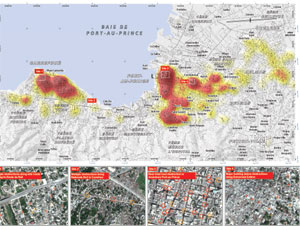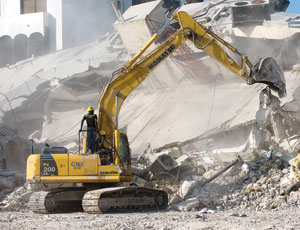The leaders of the U.S. earthquake response effort in Haiti say they expect it will be “several weeks” before the effort shifts from a first-response life- support mission to planning for recovery, but when it comes, that phase “will involve all the military and civilian subject-matter experts.”

But a week after the Jan. 12 quake, the answer to how the international reconstruction effort will be led—or even by what country or international body—was unclear. It wasn’t exactly a turf war developing among various interests, but it was the biggest unanswered question in the room, left for resolution after the initial search-and-rescue rush fades into the slow grind of reconstruction.
“We are focusing our efforts to deliver the immediate emergency supply and distribution of humanitarian aid to the stricken people of Haiti,” said U.S. Army Maj. Gen. Dan Allyn, deputy commander of the joint task force managing the tactical response to the disaster at a press conference on Jan. 19, as a full day passed since the last reported survivor was pulled from the rubble. “That’s the immediate priority and what we have been working on 24/7 for a week now,” he said.
“At the tactical level, obviously we are bringing in combat-heavy engineer equipment as part of the earthquake-response flow to enable the immediate clearing of roads and removal of rubble. That flow will be begin here in the next week,” said Allyn.
He said one immediate project that should commence within 48 hours is the construction of a second airstrip for C-130 operations at Jacmel, about 25 miles southwest of Port-au-Prince.
Allyn said he was sure “discussions are taking place at higher headquarters and among senior leadership of the Dept. of Defense and will take place with the government of Haiti as we move to the reconstruction phase,” he said, adding, “we are several weeks from moving with that phase.”
Tim Callaghan, head of the U.S. Agency for International Development’s disaster-assistance response team, said debris removal and coordination will begin much sooner and include hiring local labor to support the economy.
Among the many international organizations involved, USAID is the lead U.S. agency on the mission. But as Callaghan and Allyn repeatedly pointed out, the U.S. is supporting the Haitian government in addressing its own priorities. “There are coordination meetings with government of Haiti at 8 a.m. every morning where the prime minister articulates the priorities of Haiti,” Callaghan said. “Everything that we do is coordinated with the government....Haiti is in charge of the response.”
Bottlenecks
A week into the disaster response, though, communications, transportation and logistical bottlenecks were still impeding the response. In a press conference on Jan. 18, U.N. Secretary-General Ban Ki-moon, just returned from the scene, noted that the “most important issue at this time” was how to coordinate the fast, effective delivery of aid without waste. “The international community supports the United Nations to take the leading role as a coordinator,” he said. “There is no doubt and no question about that. The U.N. will continue to do that, and we will try to have a mechanism established in a more structured way,” Ki-moon said.
However, as he described how the “overwhelming situation” of bottlenecks at the airport and on the roads was...



Post a comment to this article
Report Abusive Comment